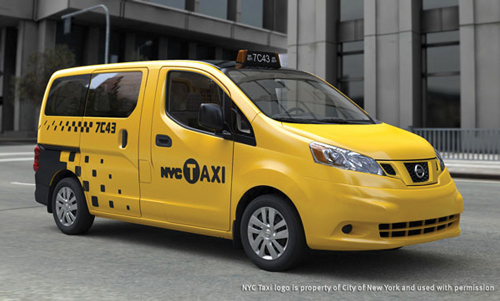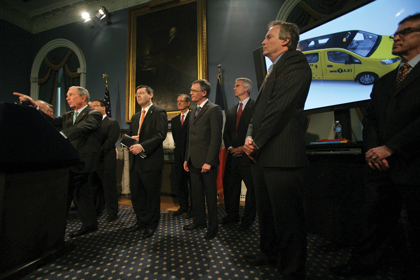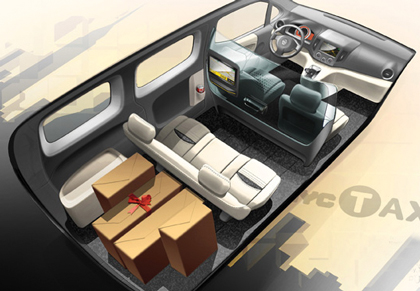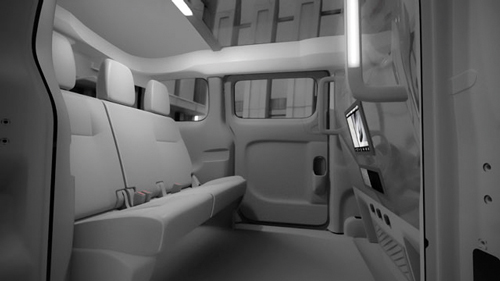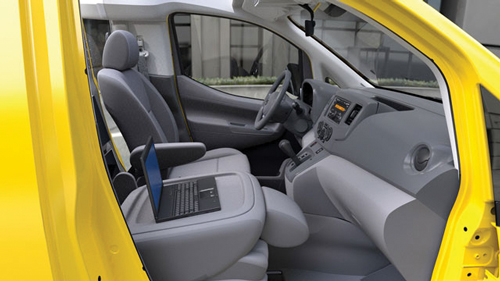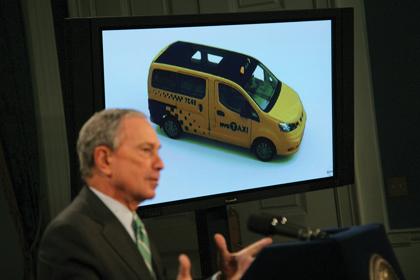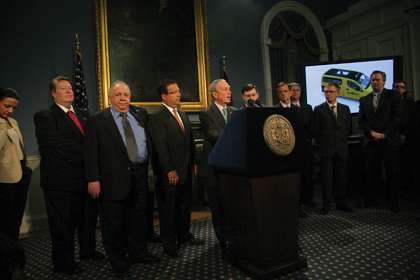|
|
MAYOR BLOOMBERG ANNOUNCES NISSAN NV200 AS THE TAXI OF TOMORROWSafest NYC Taxi Ever; Passenger Airbags and First Vehicle Ever Crash Tested with Taxi Partition and Components Installed Nissan's Vehicle Scored High on Major Categories Preferred by New Yorkers Surveyed:
Mayor Bloomberg, Deputy Mayor Goldsmith and Taxi and Limousine Commissioner Yassky announced that the NV200, designed by Nissan North America, Inc., has been chosen as the winner of the Taxi of Tomorrow competition. May 03, 2011. Photo: Edward Reed
Mayor Michael R. Bloomberg, Deputy Mayor Stephen Goldsmith and Taxi and Limousine Commissioner David Yassky announced that the NV200, designed by Nissan North America, Inc., has been chosen as the winner of the Taxi of Tomorrow competition. The City now will enter into final negotiations with Nissan to make the NV200 the first taxicab specially built for use in New York City and the City's exclusive taxicab for a decade. The NV200 will be the safest taxi ever used in the City. It will be the first cab with passenger airbags and the first to complete U.S. National Highway Traffic Safety Administration crash testing with the taxi partition and taxi equipment installed. The vehicle has many of first of its kind features, the most comfort for drivers and passengers including:
"The City's Taxi of Tomorrow is the Nissan NV 200 and it's going to be the safest, most comfortable and most convenient cab the City has ever had," said Mayor Bloomberg. "We started this process to leverage our taxi industry's purchasing power to get the highest quality taxi, one that that can expand and redefine the legendary image of New York City taxicabs. The new taxis will be custom designed to meet the specific demands of carrying 600,000 passengers a day in New York City traffic. The vehicle meets the top priorities identified by the public in our on-line survey." "Today we are announcing not the end of a process, but the beginning of one," said Deputy Mayor Goldsmith. "In partnering with Nissan North America, we have leveraged our purchasing power to improve service for both passengers and drivers alike. Our taxi industry is a vital part of our transportation network, and this partnership will ensure that it plays a central role in an innovative, sustainable future for our City." "Never before in the 100 plus year history of the taxi industry has its combined strength been used to drive the design and creation of a purpose-built vehicle tuned to the streets it will be driving on." said Taxi Commissioner Yassky. "For the first time we'll have a taxicab that wasn't 'off the rack' but rather custom tailored to create the best fit for the drivers, owners and passengers of our city. This is the heir apparent to the Checker, and people are going to fall "Nissan is proud to provide the next generation of taxis for the City of New York," said Carlos Tavares, Chairman, Nissan Americas. "The NV200 taxi will give Nissan the opportunity to showcase our dedication to vehicle quality and urban mobility to more than 600,000 passengers a day."
Photo: Edward Reed "New York City has the highest quality taxi service in the world, but operating taxicabs 24 hours a day, seven days a week in this great city also comes with great challenges like finding the right vehicles that meet the highest levels of comfort, safety and durability as well as being fuel efficient and affordable," said Ron Sherman, President of the Metropolitan Taxicab Board of Trade, which is comprised of 33 taxi fleets and more than 3,500 yellow medallion taxicabs. "We are therefore encouraged by the City's assurance that its Taxi of Tomorrow selection - the Nissan NV200 – will be a commercial grade, purpose-built taxicab that will meet MTBOT's high standards. If that indeed becomes the case, we will have made great progress in further improving taxi service for all New Yorkers. We are also pleased that the TLC has agreed to permit taxi owners to place interim vehicles like the Ford Transit Connect taxicab into service as early as next month which helps our operators continue running purpose-built taxicabs." The goal of the unique, two year long Taxi of Tomorrow procurement process was to leverage the buying power of the combined taxicab industry to produce a superior taxicab that will offer both passengers and drivers alike a safe, comfortable ride with never before available amenities. It is anticipated the first "Taxi of Tomorrow" will be introduced into service in late 2013. As part of the regular phase out of taxis the current fleet on the road will be retired out of service within three to five years depending on whether they are in use part or full time, and replaced by the Nissan NV200. Nissan will be able to manufacture the NV200 to run on electric only power starting in 2017. The City will test the use of all electric powered taxis starting in 2012 with six fully electric Nissan Leafs, provided free of charge, to road test electric vehicles. If the pilot proves successful the City will explore the possibility of the wider use of electric powered taxis.
Safety
[1] Fuel efficiency was not used as a specific criterion for evaluation.
The evaluation process focused on two major categories:
In the first category, evaluators considered the organizational capability of the proposer and relevant experience of the proposer. In the second category, evaluators reviewed such areas as the:
A public survey of taxi vehicle preferences elicited nearly 23,000 responses from the riding public, and the survey results were used to ensure the evaluation process met the needs and desires of passengers. Survey participants' top three taxi priorities, in order, were:
Photo: Edward Reed
Vehicle durability, ease of repair, and quality repair services are especially important to the taxi industry since taxis are on the road 24 hours a day, 365 days a year and operate in all weather conditions in a challenging urban environment. The choice of Nissan will meet taxi owners' needs:
The Taxi and Limousine Commission recently launched a plan to create an effective, city wide Wheelchair Accessibility Dispatch System utilizing information gained over the course of a two year pilot program. The program, which is currently proceeding through a Request for Proposals process would allow wheelchair users to call 311 for pick-up anywhere in the city by either an accessible yellow taxicab or an accessible for-hire vehicle. Additionally, Nissan has designed a wheelchair accessible version of the NV200 that it will make available to any taxi purchaser at an additional cost. The City's Department for the Aging will also work with Nissan to identify and incorporate design features like the aforementioned hand grips, safety step and extra large entry room to make the vehicle even more age friendly.
Nissan North America is headquartered in Franklin, Tennessee. The company employs more than 11,000 people at its facilities throughout the U.S. which include manufacturing plants in Smyrna and Decherd, Tennessee, and Canton, Miss., as well as design, engineering, sales, administrative and parts distribution locations across the country. The company produces more than 3.2 million vehicles per year.
Photo: Edward Reed © 2013 TLC Magazine Online, Inc. |

